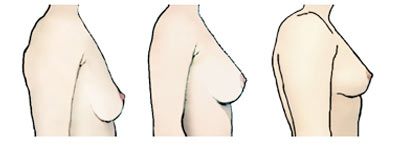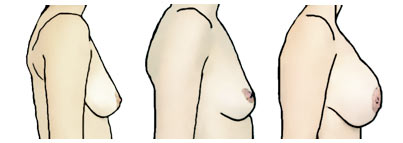Let's take a journey through the next few pages together. Get to the end, and I promise you'll have a better fitting bra size.
HerRoom CEO/Founder
Breasts are held in place on your chest by ligaments called “Cooper Ligaments.” There are no muscles that can be exercised to move your breasts back up once they begin to fall. It is the stretching over time of these ligaments that causes the southerly movement of your breasts. And, the only way to stall this movement is to have your breasts fully supported, and their movement diminished throughout the day. You should also wear sports bras with the appropriate impact level while exercising.
All four breast positions identified below are very common. And, you can experience all four of these breast positions throughout your life.
- TOMIMA

When looking at the breast in profile, the bottom of the breast is perpendicular to the chest wall. A bra is not needed to give a full look to these breasts, but should be worn anyway to maintain their position and shape. Self-supporting breasts are very common in post-pubescent girls and women with breast implants.
Wearing supportive bras on a daily and consistent basis can keep your breasts self-supported for a lifetime. Going braless, wearing ill-fitting bras, and not wearing appropriate impact level of sports bras will cause you to lose your self-supported position.
All bra styles on the market can be a success for you if you have self-supported breasts.

In profile, semi-supported breasts are beginning to drop. You have a clear breast crease line along the bottom of your breasts where they meet up with the chest wall. A bra may not be needed, but in order to maintain your breast placement and shape, a bra with good support should be worn throughout the day, and during athletic activities.
Wearing supportive bras on a daily and consistent basis can keep your breasts semi-supported for a life-time. Going braless, wearing ill-fitting bras, and not wearing appropriate impact-level sports bras will result in your breasts moving further south.

Settled breasts in profile have dropped so that the nipple is above the breast crease line, but your lower breast mass is below the breast crease line on the chest. Settling can occur after pregnancy, breast-feeding, weight loss, aging, improper bra wearing, or any combined.

Pendulous breasts are when the nipple and the lower breast mass are below the breast crease line on the chest. This breast position is common after childbirth, breastfeeding one or many children, extreme weight loss, a severe illness, improper bra usage, and, in general, as we age. Proper lifetime breast support can significantly reduce and even prevent pendulous breasts from forming.
Find your best bra size
Fast
No measuring tape needed
Let's take a journey through the next few pages together. Get to the end, and I promise you'll have a better fitting bra size.
HerRoom CEO/Founder
Find your best
Bra Styles
By Tomima
You know your bra size. But, do you know your breasts? Sounds like a funny question, but certain bras styles and features work better for some breasts and not for others.
Answer the following questions, and I promise your new bras will make you look younger and thinner!
We are sorry we are unable to assist you further.